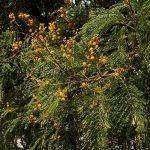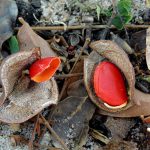TREE LIFE
MAY 1990
MASHONALAND CALENDAR
Wednesday 2nd May: Botanic Garden Walk. Park your car at the Herbarium where we will meet at 1646 hours for 1700 hours. Please note change of date – this is because Tuesday May 1st is a public holiday.
Sunday 20th May: AGM
Notice of Annual General Meeting
Notice is hereby given that the 40th Annual General Meeting of the Tree Society of Zimbabwe will be held on Sunday 20th May 1990 at 1000 hours at Harare South Country Club.
AGENDA
1 Notice Convening the Meeting
2 Apologies
3 Minutes of 39th AGM
4 Matters arising
5 Chairman’s Report
6 Treasurer’s Report
7 Election of Committee Members
8 Any other business
Refreshments – i.e. tea, coffee and sandwiches will be served (for $1 per person) at 0930 hours. After the AGM we will explore and have our picnic lunch in the woodland beyond the cricket field. However, a very nice lunch will be available at the club for any one interested.
Saturday 26th May: NO walk with Mark this month.
Sunday 27th May: The “Around Harare” National Aloe Rally. Starting from the MUKUVISI WOODLAND ENTRANCE AT 0845 HOURS FOR 0900 HOURS. Competitors leave at two minute intervals after the briefing.
The Aloe Society invite Tree Society members to compete in the National Aloe Rally and enjoy a fun-filled day. Two to a team – bring pencils, rubbers and a clip-board, binoculars are good for reading signs. We return to the Woodland for a picnic lunch and prize giving. So please also bring a camp chair, hamper and refreshments. However, tea and soft drinks will be available all day at the Kiosk and Hot Dogs will be on sale at lunchtime.
Entrance fee of $2 per person at the Mukuvisi Woodland for use of facilities and guarding of cars etc. Entry fee for Rally $1 per person. Several prizes besides the cup for the Aloe Society winner/s will be presented. Preparing the route sheet is really quite a lot of work and nothing would please us more than to see a good turn out – SO DO COME ALONG AND JOIN IN. Questions are general so all you have to do is to be observant and imaginative! For further information please phone Minkie on 50055.
MATABELELAND CALENDAR
Sunday 6th May: To Springs Farm, for a morning outing. Meeting at 0830 hours at Ascot Car Park.
Friday – Sunday 25th-27th May: Our Adventure Trip to Tuli-Shashi. Meet at Graphotype, 81 Plumtree Road at 0800 hours. After sorting out (anything over can be left under lock and key) we will go to Gwanda and 5km beyond turn right, new territory for most of us. There are 2 dormitories, ablution with water a type of kitchen and fully fenced camping area. We will have to be self contained with bedding and utensils. Ian and Ken will be taking trailers to help out. We are lucky to be having Kim and Meg joining us to help with the expected influx of new species. A first time extended Tree Outing. If a success, there are lots more waiting out there.
The cost for the week end: A donation of $10 per adult should be handed to Betty Blake of Bulawayo so that a cheque can be sent to our host society.
Sunday 3rd June: To Matopos again, to the Bambata Cave Area. (Last time rain drove us away). Hopefully, being cooler, we can reach the Cave. Anyway Geoff has lots of trees to show us. Bring lunch and chairs, Meet at Retreat at 0830 hours.
MATABELELAND NOTES
On Sunday 1st April, no fooling, we went to the Quiet Waters Area of Falcon College. We used the excellent New Field Cards produced by Ken. Of course, we found several additions. We split up into several parties, on different trails.
I give the details of the longest trail “G”. There we identified some 65 species. Of interest were (in numerical order owing to the card arrangement) : Ficus sur, Faurea saligna, Ximenia caffra, with some variation in colour,
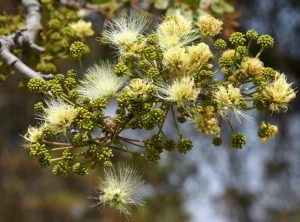
Albizia antunesiana. Photo: Bart Wursten. Source: Flora of Zimbabwe.
Albizia antunesiana, Acacia gerrardii, A. karroo and A. sieberana, Burkea Africana, (NOTE – separate this from Albizia antunesiana – Burkea leaflets are alternate – whereas Albizia antunesiana leaflets are opposite). Many Mundulea sericea, some quite large, some fine Mukwa – Pterocarpus angolensis, Lonchocarpus capassa, Croton gratissimus, Rhus pyroides, R. tenuinervis (at first thought to be Allophylus alnifolius), Maytenus heterophylla, Cassine matabelica, Azanza garckeana, many Flacourtia indica, with very varied leaves, Cussonia natalensis, Diospyros lycioides, D. mespiliformis, Strychnos madagascariensis, a very fine big tree, many rubber trees, Diplorhynchus condylocarpon, many Vitex payos, Crossopteryx febrifuga.
Also additional to the card were Ficus cordata (salicifolia), Rhoicissus tridentata, Cissus cornifolia, 886 Strychnos madagascariensis, 1089 Sericanthe andongensis (Neorosea). The truck party added a further dozen species, not encountered on “G” : Bolusanthus speciosus, Ormocarpum trichocarpum, Elephantorrhiza goetzei, Kirkia acuminata, Commiphora schimperi, Securidaca longepedunculata, Sclerocarya birrea, Cussonia arborea, Strychnos cocculoides, Clerodendrum glabrum, Canthium lactescens and addition to the Card 890 Strychnos potatorum.
There was, indeed a good variety on the different soils, so we all had a most interesting day.
-C. Sykes
NYARUPINDA CATCHMENT
The rainfall for the growing season was 600mm. the heaviest fall was 66mm on March 26th, that storm and a few showers in April have almost filled the dam on the Nyarupinda River near the house, this augurs well for the cropping programme.
Julbernardia (Mnondo) in arid situations is still flowering. The caterpillar pod shrub, Ormocarpum kirkii looks beautiful in the evening light when the muted mauve blossoms come alive, these are persistent and smell of marjoram or hops (beer flavouring). Pappea capensis is secretive like
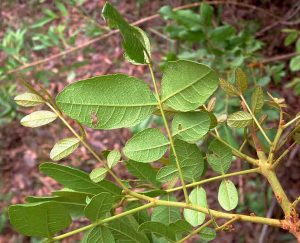
Zanha africana. Photo: R. Burrett. Source: Flora of Zimbabwe
Zanha africana, both have a short flowering period and are conspicuous when in fruit. Those of Pappea are amusing to look at because one, two or three seeds may become mature, if there are three, the style, like a beak, is centrally erect, otherwise it is basal with one or two undeveloped capsules beside it. The overall effect resembles slender bunches of green grapes. Some flower spikes of Pappea are staminate (stamens only) and some are bisexual (stamens and ovules present) each on a separate tree.
Pterolobium stellatum is a vicious liane on termite mounds, kopjes and along water courses; now its cream coloured spikes ramble over the vegetation, later its fruits show up like a Bouganvillea in the veld.
Rhus tenuinervis is adorned with a froth of lime green whereas the flowers of Senna singueana are bold and yellow. Visitors to Zimbabwe during these beautiful months will surely remember Winter Cassia – winter Senna.
Towards the end of the rain Tinnia rhodesiana begins to show, it is a small leaved shrub with shoulder high arching stems which are produced annually from a perennial root stock. The slender stems bear numerous inflated calices enclosing “black” flowers, each has two bright yellow stamens. Two characteristics of the genus Tinnia are unusual for the family to which it belongs, LAMIACEAE (LABIATAE) which includes the Salvias, Lavender, Mint and rosemary which are all related.
- Tinnia does not have square stems
- The nutlets (seeds) are winged
This shrub in flower now, is a joy to behold and inside the “balloon” another art treasure awaits the botanist, the nutlets, perfectly juxtaposed. This genus was named after a Dutch lady called Mrs Tinne who went on a botanical expedition to the source of the white Nile in Lower Sudan.
WOOD COLLECTIONS – There are many different kinds of wood collections, here are four examples :
- Experts who are able to identify wood with a hand lens only require thin slices of wood for this purpose. These specimens are preserved and displayed in the allotted plastic pages or sleeves of a photograph album
- Mr. Trevor Gordon made a collection of small cubes of heart wood which were polished to reveal the beauty of the grain. These were donated to the wood specimen library at the Forest Research Centre.
- At Tinto the samples occupy a lot of space because they are “in the round” with their bark. Some duplicates are cut to show the three planes of wood; transverse, radial and tangential. The purpose of this collection is to learn more about trees.
- A timber company may display short length of board, sawn radially or tangentially, these are planed and polished then hooked onto pegs so that they can be handled by customers
Here is a homely example to explain the three planes of wood in a tree trunk or branch. Consider a wedge shaped slice of iced cake which was cooked in a round tin :
Transverse = the three cornered area of icing
Radial = the four cornered area adjoining the next slice
Tangential = the four cornered area which touched the side of the tin
Hence the upper and lower surfaces of the cake are in the transverse plane and would be called “end grain” if they were wood. A wavy edge is cut in the tangential place, 4 cuts like this make a square cake!
WOOD COLLECTING
The wood sample collection here began in 1977 when the basin for the dam on the Nyarupinda river was cleared. Employees brought in sized pieces of indigenous timber labelled in Shona. The Rhodesian Botanical Dictionary of African and English Plant Names by Dr. Hiram Wild gave each species its Latin name and this in turn led to each having the National Number inked on the end or in a recess carved into the bark.
These logs were dried carefully in a cool, airy place indoors. Several months later they were hand sawn into 15cm lengths, using the fine toothed side of a pruning saw. It was not long before this tool needed sharpening. The following are examples of why indigenous timber is notoriously difficult to cut:
Julbernardia globiflora has an interlocking grain.
Acacia nilotica infiltrated with silica.
Commiphora africana is woolly and fibrous.
Bauhinia petersiana is cross grained.
Dichrostachys cinerea extreme hardness is due to an abundance of red gum deposits in the sap wood and tannin and darker coloured deposits in the heartwood; this is one of the most beautiful samples to look at and touch.
In spite of lacking the tools for the job, that is, a saw with tungsten tipped teeth and adequate saw power, these samples are something to be proud of and preserve for posterity.
Preservation from attack by insects and fungi is achieved by spraying the samples every few months. The cut surfaces need tidying up by sandpapering them every few years. The samples are kept on narrow shelves (facing west) set on small metal brackets, there is a gap between the inner edge of the shelf and the wall to ensure that the air circulates around the wood. These shelves are at a convenient height to sit and enjoy this collection.
Many of the samples are not thick enough to contain heartwood, but it is surprising how many trees have it in branches of narrow diameter. To date about 100 species are represented in the Tinto collection. The heaviest is a thumb sized piece of Tamarind tree of which 1 cu.ft. weighs about 75 lbs. (1 cubic metre weight 122 kg). The lightest is the local but rare equivalent of Balsa wood called Ricinodendron rautanenii which Meg Coates Palgrave brought from the Kalahari sands of Matabeleland. There are only a few fragments but a cubic foot of this wood weighs 13lbs. It is described as “very light”.
On Sunday 11th March a bird of prey came to the pool in the garden. For a long time it stood on the coping at the shallow end near the steps. Warily it entered the water and stayed on the top step for several minutes then it got out, rested, then went up into a Mfuti tree where it stood on one leg and attended to itself. Later it flew to a horizontal pole of a thatched screen, where it walking uneasily back and forth. Later, when it had gone, a blood stained footmark was observed beside the pool where it had been. The spoor was nearly 13cm from the tips to the outer claw to the back of the hind claw. This almost human activity of bathing its injured foot whilst on the step of the pool was a very good reason for calling this large brown slow flying bird a Steppe Buzzard. When Stan Fourie (our bird Atlas coordinator) heard of this incident and the description of the bird he confirmed its identity.
MUKUVISI WOODLAND NOTES
Last month we got to the Muhacha groves in the north east sector of the Woodland. I must now mention the Secret Forest, in the early eighties when we were a small group of enthusiasts only, the name was Sievis’s Secret Forest, but there were too many ss’s and no disrespect John, we abbreviated it. I frequently feel a fool using the word “forest” at all, when talking to overseas people who expect a forest to run to hundreds of square kilometres. I am always prepared to acknowledge a certain verbal extravagance parallel to our use of the word River when if you fall in, all that happens, is you get dusty.
However, call it what we may, the Secret Forest is a very special place, closed canopy Parinari with Ficus sur and Celtis africana emerging form the canopy. With a rich under storey developing although in fact both eland and baby elephants try and inhibit this latter process. I should hesitate a long time before I label this little plot of land ‘near to pristine’, however it is getting to look like a model of what the really pristine vegetation possibly looked like say ten thousand centuries ago. If we were able to assemble known facts and punch them into a magic computer, it might churn out something like our secret forest.
We may conjecture how this important chunk of the environment has managed to survive. Looking at the map we can see it is more or less dead centre of the Woodland. One only needs to extend this slightly to suggest that real conservation started here when a few hundred year ago this was a burial place. Interestingly, when much later, in a time a primitive tribe of people gathered here and constructed Coronation Park Racing Circuit, future anthropologists please note this strange ritual was designed to honour a great white queen far away across the water, this primitive tribe made a big bend in their circuit and named it Dead Cow Corner. Tragically it was at this spot that the fatalities on this race circuit happened.
An important component of the under storey here is Dovyalis zeyheri and I have very fond memories of the late Judy Reid teaching me how to identify this plant, more or less just at about this spot. How quickly things pass into history, it is important in the folklore of the Woodland to remember how Judy and Jack ran the Makabusi Woodland Walkers for years and years, in fulfilment of the almost biblical injunction ‘to use it or lose it’ following our win in the high court.
Every Tuesday evening come rain or shine, the Walkers used the Woodland and so helped materially to prevent us ‘losing’ it in the days when there was a very real danger of such happening.
Small in area though it is, the Secret Forest creates a real ecotone, forest/grassland on it boundary thus making a richer than average floral area. It is important that all concerned in present and future management of the Woodland come to realise the great importance of the vegetation here. The antelope and zebra are vital, but let us all remember, these mammals are being conserved in many situations. There is only ONE Secret Forest.
-G.Hall
A CANOE TRIP continued
A most satisfactory start for all of us and now it was time to set up camp, wash in crocodile infested waters and then have a well earned whisky and Zambezi water. The washing created much mirth and what with naked matrons bathing by the stream and the absence of any other facilities it was a good thing we were all friends of very long standing!! Fortunately we had all made certain that plenty of Scotland’s finest was available and sipping a glass of Chivas Regal on the banks of the Zambezi seemed to us to be a fine example of savoir faire. After an excellent supper of mince, rice and veg cooked by Titch and Anthony and after some of Charlotte’s jokes followed by one or two unrepeatable stories from Ben and a few golden oldies from me, off to bed!!
However, this did not prepare us well for the rigours of the night and I found the hard ground not at all conducive to a good sleep. Police reserve duty all those years ago made me think that I could sleep anywhere, but not any more!
However, the morning brought relief and an early start and a glorious sunrise as we set off on our second day into the trip. The river was almost iridescent it was so calm. A Fish Eagle gave his mournful cry and we were accompanied for a while by a Sacred Ibis singing his way down the river. Game is sparse as they have all moved back into well watered areas after the good rains. We saw a couple of buffalo, old dagga boys, a few impala and crocs and plenty of hippo.
The bird life is magnificent and April is the best time to be on the river if you want to see birds. We compiled a list at the end of the trip with the help of our guides, and had a final count of 92. Along the banks we saw many white crowned plovers, blacksmith’s plovers with their strident call, the water dikkop, the Kariba battery bird, so named as its call sounds as if it is running down. Pied wagtails and pied Kingfishers also frequent the banks. In the reeds we saw the red bishop bird, blue cheeked bee eaters, masked and speckled weavers busy attending to their intricate nests. White winged terns were much in evidence some in their breeding plumage. Egyptian Geese abound as do the cattle egret and greater egret.
We pulled into the bank for breakfast after a couple of hours paddling and really appreciated the scrambled eggs, bacon, tomatoes and fried bread cooked up by Anthony and Titch. We needed our strength for the next stretch. We canoed across the river and went some way close to the Zambian bank, which had some beautiful thick bush including some beautiful specimens of
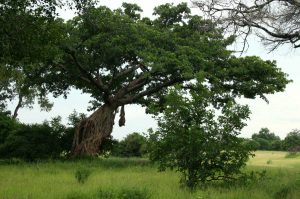
Ficus bussei. Photo: Bart Wursten. Source: Flora of Zimbabwe.
Ficus bussei. The river seemed incredibly wide when we crossed to the opposite bank and we marveled at the volume of water, at times we had the sensation of going down hill. Lunch the second day was under an Acacia albida and Natal mahogany growing so close they were almost one. There was a lovely herd of impala grazing nearby. We had some keen fishermen in the group and Keith and Dave had a rod in the water at every stop. They had moderate success and caught the odd tiger and a couple of small bream, they had some good runs later when we were at Rukomechi, but the star fisherman of the trip was Cathy who I think, caught the biggest tiger and the most fish.
Jim and Ann Sinclair – to be continued
DICK HICKS CHAIRMAN


